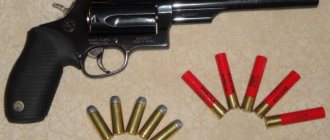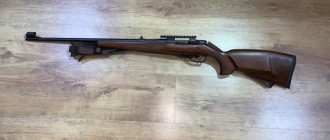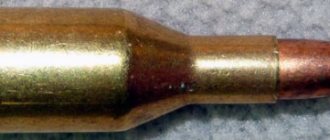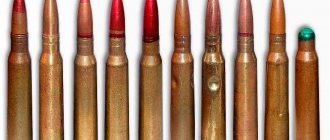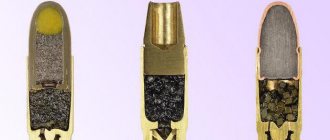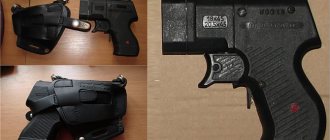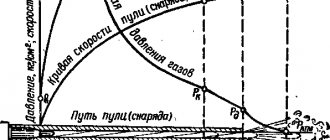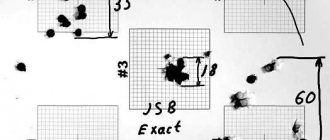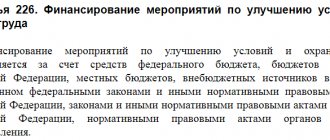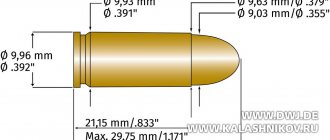Composition and internal structure of the cartridge
Traumatic weapons are mainly used for self-defense, so the projectile must have a good stopping effect. But it is also used for training shooting, therefore it must also have such characteristics as shooting accuracy.
10x28 was developed for the Grand Power T12 pistol, which was based on the K100. It used 10x22 caliber, but was unreliable due to its insufficient length, which caused many problems when shooting. The 10x28 is similar in size to the 9x19, but due to the optimal length, ammunition delays in the magazine no longer occur.
As a result of modernization, it was possible to achieve an increase in the reliability of pistols and the creation of ammunition, which made it possible to adapt the combat model to a traumatic one. This is how the Steyr M-A1 pistol was created based on the T12.
The 0x28 is similar in length to the Luger and therefore fits in the entire length of the magazine. Feeding into the chamber from the magazine is easy, without previously encountered problems.
Thanks to the increased diameter, the bullet's mass and energy increased, which improved the characteristics and reliability of modern trauma weapons.
Dreams Come True. Light and sound cartridges "Tehkrim".
Light and sound cartridges JSC "Tekhkrim"
Since February 2015, a new direction has appeared in the product line of Tekhkrim CJSC and began to actively develop - light-sound cartridges. This topic was developed in collaboration with and with their desire to produce SHP weapons (decommissioned cold weapons with the ability to simulate firing with light-sound cartridges).
When developing and designing light-sound cartridges, the task was to create a simple and technologically advanced cartridge that would provide complete authenticity when simulating shooting in comparison with similar military weapons. Immediately at the design stage, a decision was made to create new calibers of cartridges with their subsequent certification as light-sound cartridges. This decision is due to the fact that SHP weapons are on free sale, without a license. This means that ammunition for such weapons must be available and sold without a license. Thus, the production of blank cartridges for firing from SHP weapons does not make sense, since blank cartridges are sold under license. In this case, a person who has only an SHP weapon in his hands will not be able to legally buy ammunition for it. That is why the legal status of light-sound cartridges allows sale without a license to owners of SHP weapons.
The first light-sound cartridge developed by Tekhkrim CJSC was the 10x31 caliber cartridge. The cartridge was developed to simulate firing from weapons of the PPSh-SKh and TT-SKh models. PPSh-SKH and TT-SKH are produced on the basis of the legendary models of military weapons - the Shpagin submachine gun and the Tokarev pistol, including those produced during the Great Patriotic War. Making technical changes to the main parts of the weapon eliminates the possibility of using them in firearms.
The original PPSh combat submachine gun and TT pistol were designed for the 7.62x25 caliber cartridge. When designing the 10x31 caliber cartridge, the 5.45x39 automatic cartridge case was taken as a basis for the easiest possible adaptation of PPSh and TT combat models. The 10x31 caliber cartridge consists of a 5.45x39 case, cut to 31 mm, equipped with a pistol-type primer, and a charge of pistol powder with a high burning rate. The sleeve is rolled with a six-point rolling - star. On top of the rolling, the cartridge is coated with green varnish for sealing. The maximum pressure in a 10x31 caliber cartridge, according to calculations, is no more than 180 MPa, which is comparable to the maximum pressure of powder gases developed by 7.62x25, 9x19 and 9x18 caliber cartridges. Thus, the 10x31 caliber cartridge has a large reserve of power, which allows it to be used as ammunition to simulate shooting from both weapons designed for pistol cartridges and weapons designed for more powerful ammunition. Also, due to its dimensions, the 10?31 caliber cartridge is well suited for adapting 9x19 Luger combat weapons into SHP weapons.
The next light-sound cartridge after 10x31, developed by Tekhkrim CJSC, was the 10TK caliber cartridge. It was designed for the PM-SKH pistol - an adaptation of the combat PM for a decommissioned weapon. 10TK, by analogy with the 10x31 caliber cartridge, is manufactured on the basis of a 5.45x39 cartridge case. When designing the cartridge, it was necessary to ensure stable operation of the automation, to avoid problems with feeding the cartridge from the magazine into the chamber, and at the same time to fulfill the requirements of criminologists, namely: the inability to place a live cartridge of 9x18 caliber in the chamber of a decommissioned, cold weapon of the PM-CX model and fire a shot. Based on this, the optimal length of the 10TK cartridge case was selected, amounting to 22 mm, while the loaded cartridge itself has a length of no more than 21.5 mm. Thus, the 10TK light-sound cartridge turned out to be shorter than the 9x18 combat cartridge, and when you try to load a 9x18 combat cartridge into the PM-CX chamber, the bolt does not close, so there is no possibility of firing a shot. At the same time, the selected dimensions of the 10TK cartridge ensure trouble-free operation in PM-SKh weapons. The design problem was successfully solved. By analogy with the 10x31 cartridge, the 10TK cartridge is also loaded with pistol powder with a high burning rate and rolled with a 6-beam star rolling; the rolling is also covered with a green sealing varnish on top.
Since decommissioned, cold weapons are mainly intended for use for cultural and educational purposes, as well as for participation in historical reconstructions, the factor of reliability and authenticity of simulating shooting from this type of weapon is important. The shooter and observer should get the impression that they are shooting from a “real”, “combat” weapon.
In order to achieve such reliability, at the stage of designing cartridges, a comparative analysis was carried out when simulating firing with light-sound cartridges 10x31 and 10TK and cartridges of 7.62x25 and 9x18 calibers. The comparison was carried out according to such parameters as sound pressure level, fieryness, realistic operation of the automation, overall effect, impressions of the shooter and the viewer. By the way, the sound pressure level when firing a 10x31 caliber cartridge is not much different from 7.62x25 cartridges: 149 dB versus 152 dB. When firing 10TK caliber cartridges, the sound pressure level is 130 dB. The fiery quality when simulating firing with 10x31 and 10TK caliber cartridges corresponds to military weapons.
Based on the results of numerous tests, it was possible to achieve maximum reliability when simulating firing with light-sound cartridges of 10x31 and 10TK calibers. At the moment, an application has been submitted to include light-sound cartridges of calibers 10x31 and 10TK in the PMK tables. All this makes 10x31 and 10TK caliber cartridges promising and interesting for the average consumer, for film industry workers, for all kinds of SHP weapons manufacturers.
Bullet weight
The sleeve is made of steel, with a diameter of 10 mm and a length of 28 mm. The bullet is rubber, spherical, has a diameter of 12 mm, and fits into the cartridge case without any problems due to its good elasticity. After 2010, the weight of a 10x28 caliber bullet is 1.8 g. It is a black rubber ball. The appearance of modern cartridges released after 2011: the ball is recessed into the sleeve, but it is slightly rolled. The power developed by the bullet is 91 J.
10x28 cartridges on the bottom are marked “AKBS” (. They are packaged in cardboard boxes of 25 pieces. This version of ammunition is also produced by .
Muzzle energy
At first glance, it may seem that the characteristics of injury models play a decisive role, and those indicators that are inherent in ammunition can be considered insignificant. Actually this is not true. When choosing the most powerful pistol, everyone must remember that the OOOP category is not intended to cause serious injury to the enemy, and certainly does not imply death.
That is why comparisons of traumatic weapons with military or service weapons are meaningless. Moreover, manufacturers, even when producing pistols based on combat models, try to fulfill the main legal requirement - to reduce the likelihood of causing damage to health to a minimum. But this does not give reason to consider OOOP a toy. For example, getting a rubber ball into an eye, temple or artery can cause death.
First of all, you should understand the energy characteristic, because it is this that causes the confusion that often arises. Muzzle energy depends on the pistol model and cartridge. By law, it is allowed to purchase civilian weapons whose energy does not exceed 91 J. But how to assess whether this is a lot or a little? Compared to this indicator with the energy of a firearm, where the value reaches hundreds of Joules, the value of 91 J seems tiny.
Let's take for consideration the Browning 6.35 model, which shoots real bullets. This is the least powerful weapon. Its energy reaches only 60 J, but it is enough for the bullet to freely penetrate the soft tissues of the human body. It is not difficult to guess that already at 80 J there will be through penetration, bone fracture and damage to internal organs, which will lead to death.
All of the above should instill in the reader the understanding that there is a certain limit to the value of muzzle energy at which the degree of risk is already considered high. Indeed, if you shoot a rubber bullet with an energy of 91 J at a person protected by outer clothing, he will hardly feel any discomfort. But if a rubber ball hits your head, serious consequences cannot be avoided.
It is also worth considering that no one checks these balls for compliance with the standard, and if you hit a bullet made of harder rubber, or the shot is fired in cold weather, then the impact ability of the bullet will increase significantly. That is why manufacturers do not chase muzzle energy indicators, and the limit value determined by law suits everyone.
Now we list the most common traumatic cartridges. First of all, this is a 9 mm RA cartridge. Some pistols are adapted to use two or even three types of ammunition. Both bullets for a traumatic pistol and cartridge cases differ, not only in diameter, but also in length. Thus, popular cartridges are 10x22 mm, .380 IU GUM, 41 or 45 Rubber. cartridges for service weapons differ significantly from those provided for civilian ones. The list is replenished with such options as 13x45 mm and 18x45 mm.
In what injuries is it used?
Used in traumatic pistols that develop muzzle energy when firing, not exceeding 150 J. Purpose - official. The ammunition is designed for use in models of limited destruction weapons for self-defense Steyr M-A1, Grand Power T12, P226TC, TT-T and others using a cartridge of the same caliber.
The 10x28 caliber is perfect for weapons that are created by factories based on modifications using 9x19 caliber weapons. In addition to those already created, designers and manufacturers are planning to develop new models. The design of the cartridges allows for further development and enhancement of power, for example, by weighing the bullet up to 2 g.
The cartridges may be of interest for sports; their “Sports” modification shows good accuracy and has low energy. The “Standard” ones have average performance, the “Magnum” variety has the highest energy. The ammunition has prospects; in the future it may even become the most common for traumatic pistols, originally created for 9x19.
